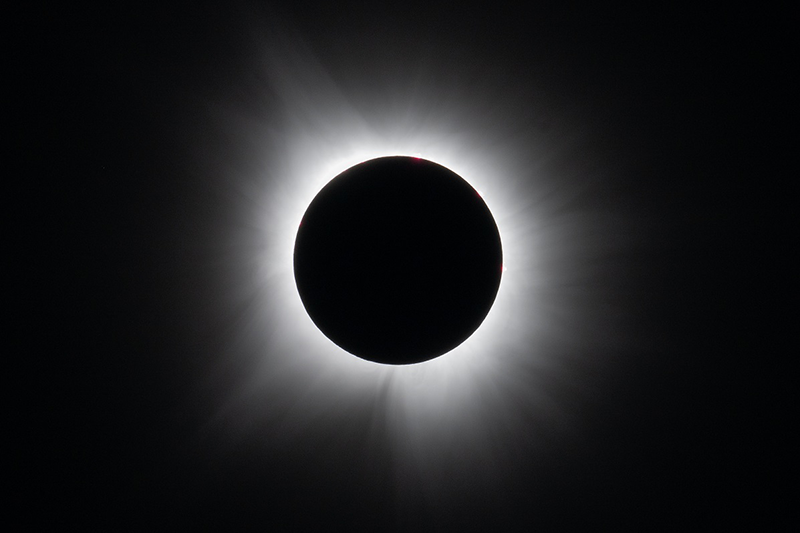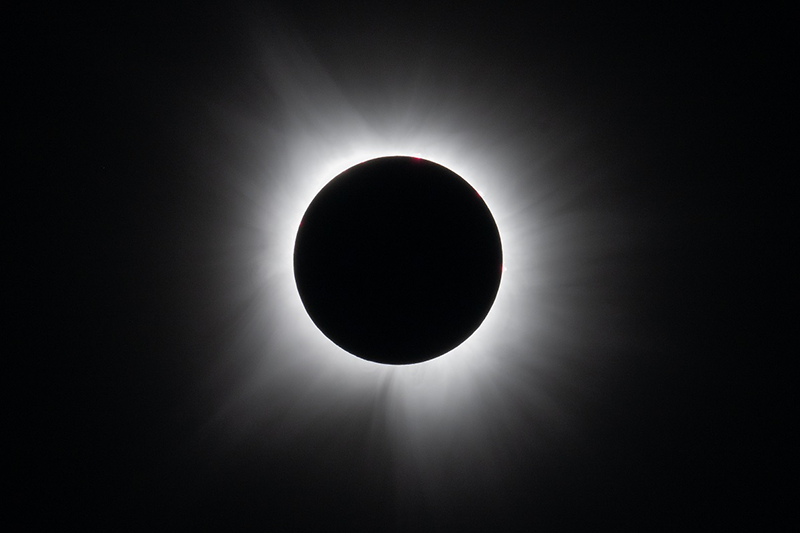Solar Composition Altered by Plasma Waves
The solar corona is a halo of hot, tenuous plasma that surrounds the Sun out to large distances. It is visible during solar eclipses (Fig. 1) but is usually outshone by the glare of the Sun’s surface, or photosphere. The corona has different abundances of chemical elements than the rest of the Sun, and a longstanding question has been why this disparity exists. New solar measurements by Mariarita Murabito at the Italian National Institute of Astrophysics (INAF) and colleagues suggest that the difference is caused by plasma waves dragging easily ionized elements from the Sun’s lower atmosphere into the corona [1]. This finding could lead to a better understanding of the structure of stars.
The corona is of great interest to solar physicists, partly because it produces the solar wind—an outflow of hot gas from the Sun. The solar wind is most evident to us on Earth when its particles become trapped in Earth’s magnetic field and collide with our atmosphere, causing an aurora. An important problem in solar physics is to determine which coronal structures generate the solar wind and how solar conditions affect the outflow’s properties. The elemental composition of the solar wind sheds light on its origins, as this composition does not change once the gas leaves the Sun. The solar wind can be directly sampled by spacecraft in situ, and its elemental abundances can be compared to coronal abundances inferred from spectroscopy.
Elemental abundances in the corona differ from those in the photosphere in a way that depends on each element’s first-ionization potential (FIP)—the energy needed to remove a single outer electron from a neutral atom. Measurements show that elements whose FIP is below 10 eV (such as silicon, magnesium, and iron) have abundances that are several times larger in the corona than in the photosphere. By contrast, elements whose FIP is above 10 eV (such as oxygen, neon, and argon) have abundances that are similar in the corona and the photosphere.
This phenomenon, known as the FIP effect, is observed in regions of the Sun where the solar magnetic field forms closed loops, such as near the solar equator. It is comparatively weaker or absent in places where the magnetic field is open (extending far out into space), such as at the poles. Additionally, solar measurements find, roughly, that slow solar wind tends to exhibit the FIP effect, whereas fast solar wind does not. These observations imply that slow solar wind comes from equatorial regions, whereas fast solar wind often comes from the poles.
What is the origin of the FIP effect? That question has been debated for decades. The material in the corona is supplied by the photosphere, and so the difference in composition is surprising. One clue to solving this puzzle comes from the fact that the FIP effect’s threshold of 10 eV matches the energy of radiation emitted by excited hydrogen atoms. In the chromosphere (a thin layer between the photosphere and the corona), low-FIP elements can be ionized by this radiation, whereas high-FIP elements cannot. This fact suggests that there is a process in the chromosphere that pushes ions, but not neutral atoms, into the corona.
Murabito and colleagues focused on one of the leading explanations for this process, which invokes so-called Alfvén waves [2]. These are low-frequency electromagnetic waves in a plasma that travel along the plasma’s magnetic field and induce a transverse motion in which the fluid and the magnetic field move together. The nonuniform electric fields of Alfvén waves apply a force to charged particles called a ponderomotive force, which is related to the radiation pressure exerted by electromagnetic waves in a vacuum [3].
In the corona, Alfvén waves moving along a closed magnetic loop bounce back and forth between the loop’s two footpoints—the locations where the loop enters the photosphere. In doing so, the waves collide with the chromosphere on both sides of the loop. At the footpoints, the waves exert a strong ponderomotive force on the ions in the plasma, dragging them into the corona, but leaving behind the neutral atoms. By contrast, Alfvén waves moving on open magnetic-field lines mainly travel away from the Sun and so do not exert a strong ponderomotive force, resulting in no FIP effect. Detailed calculations have shown that this phenomenon can quantitatively reproduce the observed elemental abundances in the corona.
To test this explanation, Murabito and colleagues combined two datasets: measurements of the FIP effect in the corona taken by the Extreme Ultraviolet Imaging Spectrometer on board the Hinode satellite and measurements of Alfvén waves in the chromosphere obtained by the Interferometric Bidimensional Spectrometer on the Dunn Solar Telescope in New Mexico. The researchers then studied a solar active region—the corona and chromosphere above a sunspot.
On one side of the active region, Murabito and colleagues found a clear FIP effect and strong Alfvén waves, some of which were moving inward toward the chromosphere. By contrast, on the other side, the researchers saw a negligible FIP effect and weak Alfvén waves, which were moving away from the Sun. These findings are all consistent with the ponderomotive-force explanation for the FIP effect, and this conclusion is backed up by additional quantitative comparisons and numerical modeling conducted by the researchers.
A definitive theory of the physics behind the FIP effect would introduce new possibilities for understanding the Sun and other stars. So far, solar physicists have used the FIP effect in a phenomenological way, such as to distinguish solar wind from closed versus open magnetic-field regions. If the FIP effect is known to be caused by Alfvén-wave ponderomotive forces, it would be possible to infer more details about the magnetic structures and Alfvén waves in the solar-wind sources. The FIP effect is also observed in other stars [4], and so understanding its underlying mechanism could give insight into the structure of the chromosphere and corona in those stars.
References
- M. Murabito et al., “Observation of Alfvén wave reflection in the solar chromosphere: Ponderomotive force and first ionization potential effect,” Phys. Rev. Lett. 132, 215201 (2024).
- J. M. Laming, “A unified picture of the first ionization potential and inverse first ionization potential effects,” Astrophys. J. 614, 1063 (2004).
- F. F. Chen, Introduction to plasma physics and controlled fusion (Springer, New York, 2018)[Amazon][WorldCat].
- B. E. Wood and J. L. Linsky, “Resolving the 𝜉 Boo binary with Chandra, and revealing the spectral type dependence of the coronal ‘FIP effect’,” Astrophys. J. 717, 1279 (2010).





